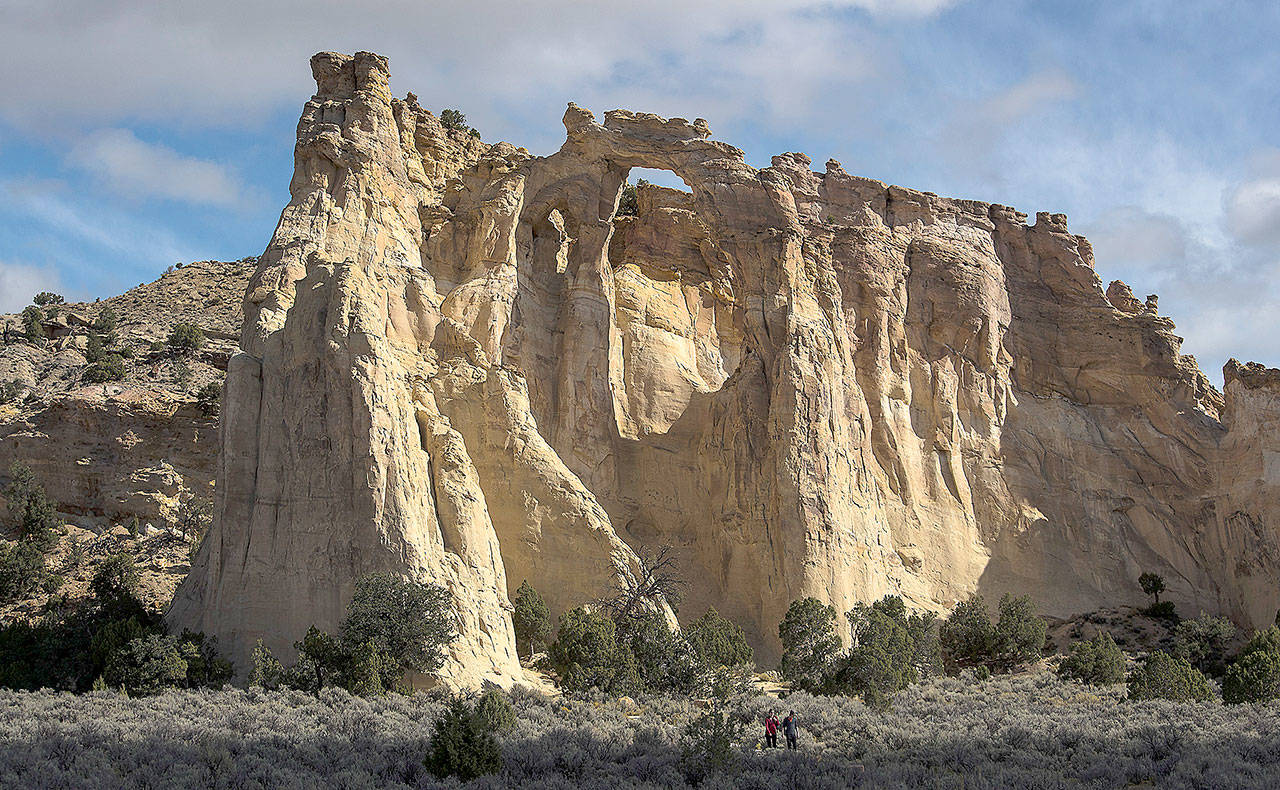By Keith Schneider
Los Angeles Times
SALT LAKE CITY — Eight months after President Donald Trump ordered a review of national monuments, and a day after the president removed 2 million acres of public land from federal protection in Utah, Interior Secretary Ryan Zinke on Tuesday announced recommendations for much smaller boundary adjustments to monuments in Nevada and Oregon.
During a conference call with reporters, Zinke said he urged the president to adjust acreage in the 297,000-acre Gold Butte National Monument in Nevada and the 100,000-acre Cascade-Siskiyou monument in Oregon. He described the changes as modest, but did not specify exactly how the boundaries would be revised.
One unexpected result of the interior secretary’s review was his recommendation to establish three new monuments, two in the south to preserve Camp Nelson a 4,000-acre Civil War training depot in northern Kentucky, and the Medgar Evers home in Jackson, Miss. The third is the 130,000-acre Badger-Two Medicine area within Lewis and Clark National Forest in northwestern Montana, and close to where Zinke was raised.
The final recommendations Zinkle made to Trump focused on adjusting the boundaries of two Pacific Ocean marine monuments — the 8.6-million-acre Rose Atoll, and the Pacific Remote Islands Monument, and changing management practices at an Atlantic Ocean monument — the 3.1-million-acre Northeast Canyons and Seamounts. The changes reflect the administration’s desire to open the areas to fishing, which have been limited by monument designations.
All of the proposed changes are within the president’s authority under the 1906 Antiquities Act to adjust boundaries and management plans, Zinke said. He also said Trump’s directive to review monuments stemmed from concerns by states and neighboring communities that previous administrations had overreached, particularly in establishing the 1.35-million-acre Bears Ears and 1.9-million-acre Grand Staircase-Escalante national monuments in three southern Utah counties.
Zinke said that in certain instances the designation of a national monument had shut down roads and trails and blocked access to recreational and grazing lands that had been used for generations.
“The Antiquities Act was designed to protect rather than prevent the public use of land,” he said. “No president has the authority to remove the public from their land. The president was absolutely right in asking for a review.”
The administration’s review, particularly the decisions to shrink Bears Ears and Grand Staricase-Escalante, has received enthusiastic support from cattlemen and rural communities across the West. It also prompted fierce criticism from Democratic lawmakers, Native Americans and environmental groups who assert that Trump does not have the authority to remove so much land from federal protection.
The administration’s monuments review is a sharp departure for American public lands management, which has been distinguished by the steadily evolving doctrine of safeguarding exceptional expanses of the national domain and expanding those protections. Trump is the first president to remove so much ground from federal protection.
Trump promised during his election campaign to disrupt policy conventions, and his decision Monday to radically alter the boundaries of the two big Utah monuments does just that.
The monuments review started April 26 when Trump signed an executive order directing Zinke to study “all presidential designations or expansions of designations under the Antiquities Act” since Jan. 1, 1996, if they involve more than 100,000 acres.
Gold Butte covers about 300,000 acres just east of Lake Mead in southeastern Nevada.
The president said he was intent on responding to longstanding complaints from rural communities in the West who said their opinions were ignored in establishing national monuments, despite a mandate for “adequate public outreach.”
Zinke determined that 22 monuments spanning 11.2 million acres in 11 states, all but one in the West, fit Trump’s description. The review also involved five marine monuments covering 218 million acres, four of them in the Pacific and the fifth in the Atlantic Ocean.
An August memo from Zinke to Trump recommended that the two Utah monuments, Bears Ears and Grand Staircase-Escalante, be reduced, along with Gold Butte and Cascade-Siskiyou.
Zinke had also recommended altering the boundaries of two national monuments in New Mexico — Organ Mountains-Desert Peaks and Rio Grande del Norte, and another in Maine — Katahdin Woods and Waters. Zinke said Tuesday that the boundaries of those monuments would remain unchanged.
—-
The boundaries of two marine monuments in the Pacific Ocean also were suggested for alteration, according to the memo.
Among those cheering the administration’s moves was Dave Eliason, president of the Public Lands Council.
“Previous administrations abused the power of the Antiquities Act, designating huge swaths of land as national monuments without any public input or review,” he said. “Rural communities in Utah and across the West have paid the price. Sweeping designations locked up millions of acres of land with the stroke of a pen, undermining local knowledge and decimating rural economies.”
The president said his decision will make it easier to undertake traditional uses of the lands in question, including livestock grazing. That brought praise from the National Cattlemen’s Beef Association. “Going forward, it is critical that we reform the Antiquities Act to ensure that those whose livelihoods and communities depend on the land have a voice in federal land management decisions,” said Craig Uden, the organization’s president.


